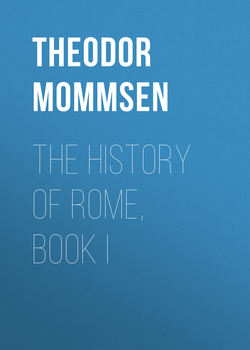The History of Rome, Book I

Реклама. ООО «ЛитРес», ИНН: 7719571260.
Отрывок из книги
When the first portion of this translation appeared in 1861, it was accompanied by a Preface, for which I was indebted to the kindness of the late Dr. Schmitz, introducing to the English reader the work of an author whose name and merits, though already known to scholars, were far less widely familiar than they are now. After thirty-three years such an introduction is no longer needed, but none the less gratefully do I recall how much the book owed at the outset to Dr. Schmitz's friendly offices.
The following extracts from my own "Prefatory Note" dated "December 1861" state the circumstances under which I undertook the translation, and give some explanations as to its method and aims:—
.....
Here settled the stock which is known to history under the name of the Latins, or, as they were subsequently called by way of distinction from the Latin communities beyond the bounds of Latium, the "Old Latins" (-prisci Latini-). But the territory occupied by them, the district of Latium, was only a small portion of the central plain of Italy. All the country north of the Tiber was to the Latins a foreign and even hostile domain, with whose inhabitants no lasting alliance, no public peace, was possible, and such armistices as were concluded appear always to have been for a limited period. The Tiber formed the northern boundary from early times; and neither in history nor in the more reliable traditions has any reminiscence been preserved as to the period or occasion of the establishment of a frontier line so important in its results. We find, at the time when our history begins, the flat and marshy tracts to the south of the Alban range in the hands of Umbro-Sabellian stocks, the Rutuli and Volsci; Ardea and Velitrae are no longer in the number of originally Latin towns. Only the central portion of that region between the Tiber, the spurs of the Apennines, the Alban Mount, and the sea—a district of about 700 square miles, not much larger than the present canton of Zurich—was Latium proper, the "plain,"15 as it appears to the eye of the observer from the heights of Monte Cavo. Though the country is a plain, it is not monotonously flat. With the exception of the sea-beach which is sandy and formed in part by the accumulations of the Tiber, the level is everywhere broken by hills of tufa moderate in height though often somewhat steep, and by deep fissures of the ground. These alternating elevations and depressions of the surface lead to the formation of lakes in winter; and the exhalations proceeding in the heat of summer from the putrescent organic substances which they contain engender that noxious fever-laden atmosphere, which in ancient times tainted the district as it taints it at the present day. It is a mistake to suppose that these miasmata were first occasioned by the neglect of cultivation, which was the result of the misgovernment in the last century of the Republic and under the Papacy. Their cause lies rather in the want of natural outlets for the water; and it operates now as it operated thousands of years ago. It is true, however, that the malaria may to a certain extent be banished by thoroughness of tillage—a fact which has not yet received its full explanation, but may be partly accounted for by the circumstance that the working of the surface accelerates the drying up of the stagnant waters. It must always remain a remarkable phenomenon, that a dense agricultural population should have arisen in regions where no healthy population can at present subsist, and where the traveller is unwilling to tarry even for a single night, such as the plain of Latium and the lowlands of Sybaris and Metapontum. We must bear in mind that man in a low stage of civilization has generally a quicker perception of what nature demands, and a greater readiness in conforming to her requirements; perhaps, also, a more elastic physical constitution, which accommodates itself more readily to the conditions of the soil where he dwells. In Sardinia agriculture is prosecuted under physical conditions precisely similar even at the present day; the pestilential atmosphere exists, but the peasant avoids its injurious effects by caution in reference to clothing, food, and the choice of his hours of labour. In fact, nothing is so certain a protection against the "aria cattiva" as wearing the fleece of animals and keeping a blazing fire; which explains why the Roman countryman went constantly clothed in heavy woollen stuffs, and never allowed the fire on his hearth to be extinguished. In other respects the district must have appeared attractive to an immigrant agricultural people: the soil is easily laboured with mattock and hoe and is productive even without being manured, although, tried by an Italian standard, it does not yield any extraordinary return: wheat yields on an average about five-fold.16 Good water is not abundant; the higher and more sacred on that account was the esteem in which every fresh spring was held by the inhabitants.
No accounts have been preserved of the mode in which the settlements of the Latins took place in the district which has since borne their name; and we are left to gather what we can almost exclusively from a posteriori inference regarding them. Some knowledge may, however, in this way be gained, or at any rate some conjectures that wear an aspect of probability.
.....